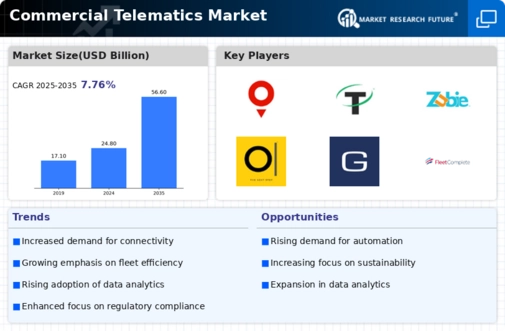Market Trends
Key Emerging Trends in the Commercial Telematics Market
This makes it a race for dominance among many competitors because the Commercial Telematics Market is a dynamic sector where everything changes rapidly. Hence, as such, technology like telematics has become important in the automotive and transport sectors because it combines telecommunications with informatics to enable vehicle tracking or communication. Perhaps one keyway that firms differentiate their products from those of other suppliers is through advanced features not found in other telematics services offered by rivals but also innovative functionalities, state-of-the-art technologies, etc. This helps them maintain customer loyalty and attract new customers. For instance, while others put their efforts into real-time data analytics tools for efficient fleet management, others concentrate on developing advanced driver assistance systems (ADAS). Moreover, Strategic Partnerships Determine Commercial Telematic Market Share Positioning Competition within the Commercial Telematics Market can be influenced by strategic alliances between different companies. This involves cooperation between OEMs (original equipment manufacturers), software developers, and other stakeholders so that they can reach out to more customers in unexplored markets. Besides, pricing strategies also play a significant role in determining market share in the commercial telematics market sphere. In order for firms to remain profitable, they must find a trade-off between providing competitive prices and keeping costs low. Some may choose cost leadership positions by applying economies of scale to give their telematics at lower prices as compared to the competition; however, others may prefer a premium pricing strategy, positioning their products as high-quality and feature-rich solutions that justify charging a higher price. Successful pricing is obtained by understanding the target market's price sensitivity, competitor pricing, and the perceived value of telematics services. Market penetration is another strategy companies use to increase their market share in the industry. This can be achieved by either increasing sales to existing customers or drawing new ones into its pool. Further, the success of the Commercial Telematics Market relies heavily on a customer-focus approach, among other factors. Consequently, leading companies in this field must strive for improved customer satisfaction with regular feedback received from them. As such, this entails understanding how client needs change over time, addressing pain points that arise in usage, and constantly improving telematics systems based on user reviews. Finally, positive client experiences lead to loyalty and act as an effective marketing tool because happy customers tend to refer others, thereby promoting organic growth.

















Leave a Comment